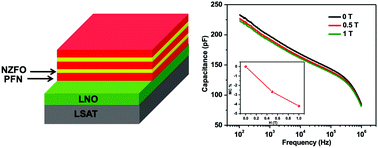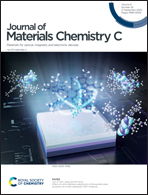Exploring phase transitions and magnetoelectric coupling of epitaxial asymmetric multilayer heterostructures†
Abstract
Magnetoelectric (ME) heterostructures can exhibit higher magnetic and ferroelectric ordering temperatures along with large ME coupling compared to single-phase multiferroic materials. We synthesized Pb(Fe0.5Nb0.5)O3 (PFN)/Ni0.65Zn0.35Fe2O4 (NZFO)/Pb(Fe0.5Nb0.5)O3 (PFN)/Ni0.65Zn0.35Fe2O4 (NZFO)/Pb(Fe0.5Nb0.5)O3 (PFN) multilayer heterostructures having dimensions of 40/10/40/10/40 nm. High quality epitaxial growth of these heterostructures was confirmed via X-ray diffraction (XRD) and selected area electron diffraction (SAED) patterns. These nanostructures show well saturated polarization (∼52 μC cm−2) and magnetization (∼62 emu cm−3) at room temperature (RT). The magnetic and ferroelectric transitions occur well above RT. These heterostructures exhibit relaxor behavior and undergo 2nd order ferroelectric phase transition. Magnetodielectric measurements show significant coupling between the magnetic and electrical order parameters at RT. These characteristics of the heterostructures make them suitable as potential candidates for ultra-low power memory, spintronics, and different multifunctional (micro)nanoscale device applications.



 Please wait while we load your content...
Please wait while we load your content...